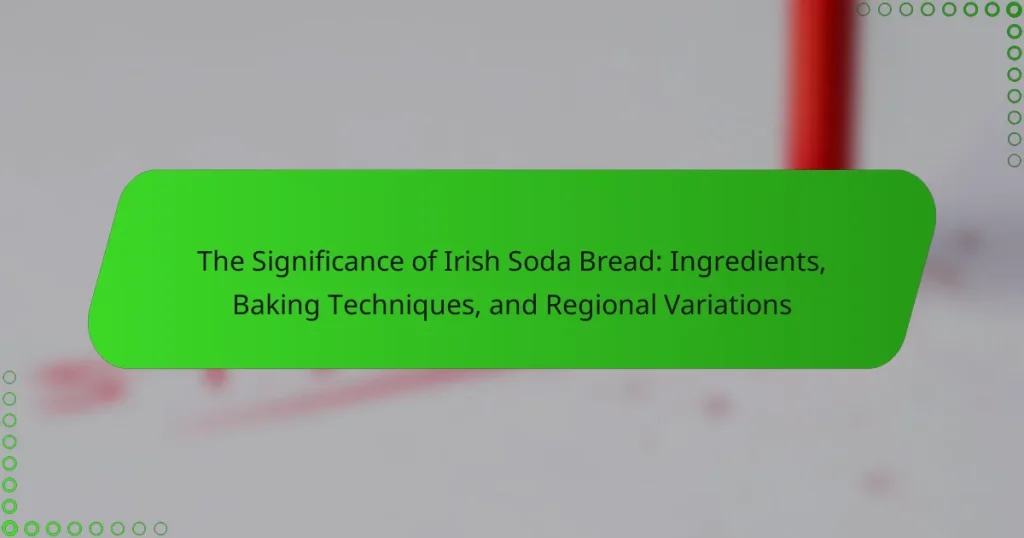Irish Soda Bread is a traditional Irish bread that utilizes baking soda as a leavening agent, differentiating it from yeast-leavened varieties. The essential ingredients include flour, baking soda, salt, and buttermilk, which contributes to its unique flavor and texture. This bread gained popularity in the 19th century and is characterized by its round shape and a cross scored on top to facilitate expansion during baking. Regional variations in Ireland influence the choice of ingredients and baking methods, with some areas preferring wholemeal flour or incorporating unique elements like caraway seeds or raisins. Effective baking tips include using fresh baking soda, ensuring buttermilk is at room temperature, and baking at a high temperature for optimal crustiness.

What is Irish Soda Bread?
Irish Soda Bread is a traditional Irish bread made using baking soda as a leavening agent. This method distinguishes it from yeast-leavened breads. The primary ingredients include flour, baking soda, salt, and buttermilk. The use of buttermilk provides a slight tang and helps the bread rise. Historically, Irish Soda Bread became popular in the 19th century due to the availability of baking soda. It is often baked in a round shape and scored with a cross on top. This scoring allows the bread to expand while baking. Irish Soda Bread is a staple in Irish cuisine and is often served with meals.
How did Irish Soda Bread originate?
Irish Soda Bread originated in Ireland during the 19th century. It was created as a quick and easy bread option for households. The introduction of baking soda as a leavening agent made this possible. Traditional recipes used simple ingredients like flour, baking soda, salt, and buttermilk. The use of buttermilk contributed to the bread’s unique flavor and texture. Irish Soda Bread became popular due to its accessibility and ease of preparation. It was particularly favored in rural areas where ovens were scarce. The bread’s significance grew as it became a staple in Irish cuisine.
What historical factors contributed to the creation of Irish Soda Bread?
Irish Soda Bread originated due to specific historical factors. The introduction of baking soda in the 19th century revolutionized bread-making in Ireland. This chemical leavening agent allowed for quicker bread preparation. Traditional yeast breads required longer fermentation times. The availability of soft wheat in Ireland contributed to the use of soda bread. Economic hardship, particularly during the Great Famine, necessitated simpler, quicker recipes. Families needed a reliable food source that could be made with minimal ingredients. Irish Soda Bread became a staple because it was affordable and easy to prepare. These historical circumstances shaped its development and widespread popularity.
What cultural significance does Irish Soda Bread hold in Ireland?
Irish Soda Bread holds significant cultural importance in Ireland as a traditional staple food. It symbolizes Irish heritage and is often associated with family gatherings and communal meals. Historically, it was a practical bread made with simple ingredients like flour, baking soda, and buttermilk. This simplicity reflects the resourcefulness of Irish households, especially during times of scarcity. Irish Soda Bread is also linked to various customs and celebrations, such as St. Patrick’s Day and Easter. The bread’s unique baking method, using baking soda as a leavening agent, distinguishes it from other breads. Its regional variations across Ireland highlight local traditions and ingredients. Overall, Irish Soda Bread is a cherished emblem of Irish identity and culinary history.
What are the key ingredients in Irish Soda Bread?
The key ingredients in Irish Soda Bread are flour, baking soda, salt, and buttermilk. These ingredients create a simple, quick bread that does not require yeast. All-purpose flour is commonly used, providing the structure. Baking soda acts as a leavening agent, helping the bread rise. Salt enhances flavor, while buttermilk adds moisture and acidity, which reacts with baking soda. This reaction produces carbon dioxide, contributing to the bread’s texture. Traditional recipes may also include additional ingredients like raisins or caraway seeds for flavor variations.
What role does baking soda play in Irish Soda Bread?
Baking soda serves as the primary leavening agent in Irish Soda Bread. It reacts with the acidic ingredients, such as buttermilk, to produce carbon dioxide. This reaction causes the dough to rise, creating a light and airy texture. Baking soda is crucial because it eliminates the need for yeast, making the bread quick to prepare. Traditional recipes often use equal parts baking soda and buttermilk to achieve the desired rise. The use of baking soda dates back to the 19th century when it became popular in Irish cooking. Its role is essential for the unique characteristics of this bread.
How do different flours affect the texture of Irish Soda Bread?
Different flours significantly affect the texture of Irish Soda Bread. All-purpose flour creates a tender crumb due to its moderate protein content. Whole wheat flour results in a denser and coarser texture because of its higher fiber content. Bread flour, with its high protein level, produces a chewier texture and more structure. Gluten-free flours, such as almond or rice flour, yield a crumbly and less cohesive texture. The hydration level also varies with different flours, influencing the moisture and final density of the bread. Ultimately, the choice of flour determines the bread’s overall mouthfeel and structure.
What are the traditional baking techniques for Irish Soda Bread?
Traditional baking techniques for Irish Soda Bread include using simple ingredients and a quick preparation method. The primary ingredients are flour, baking soda, salt, and buttermilk. The dough is mixed by hand to avoid overworking it, which helps maintain a tender texture.
Baking typically occurs in a cast-iron skillet or on a baking sheet. The shape is often round, with a cross cut into the top to allow for even cooking. This cross also serves a cultural purpose, symbolizing the Holy Trinity.
Irish Soda Bread is usually baked at a high temperature, around 425°F (220°C), for about 30-40 minutes. The bread is done when it sounds hollow when tapped on the bottom. This method has been passed down through generations, reflecting traditional Irish culinary practices.
How does the mixing method influence the final product?
The mixing method significantly influences the texture and flavor of Irish soda bread. Proper mixing ensures even distribution of ingredients, which affects the bread’s rise. Over-mixing can lead to a dense texture, while under-mixing may result in uneven baking. The method impacts gluten development, which is crucial for structure. For soda bread, minimal mixing is preferred to maintain a tender crumb. According to research, the ideal mixing time for soda bread is short to prevent toughness. This technique preserves the bread’s characteristic lightness and enhances its unique flavor profile.
What temperature and baking time are ideal for Irish Soda Bread?
The ideal temperature for baking Irish Soda Bread is 425°F (220°C). This high temperature helps create a crusty exterior while keeping the inside moist. The recommended baking time is approximately 30 to 40 minutes. During this time, the bread should rise and develop a golden-brown crust. Checking for doneness can be done by tapping the bottom of the loaf; a hollow sound indicates it is fully baked.

How does regional variation impact Irish Soda Bread?
Regional variation significantly impacts Irish Soda Bread through differences in ingredients and baking methods. In various regions of Ireland, local preferences dictate the choice of flour, whether it’s wholemeal or white. For example, Northern Irish recipes often incorporate buttermilk, while Southern variations may use sour milk. Additionally, some regions add unique ingredients like caraway seeds or raisins, enhancing flavor profiles. The baking technique also varies; some areas prefer a thicker crust, while others aim for a softer texture. These regional distinctions reflect local agricultural practices and cultural influences, showcasing the diversity of Irish Soda Bread across the country.
What are the different regional styles of Irish Soda Bread?
The different regional styles of Irish Soda Bread include traditional Irish Soda Bread, which is made with white flour, baking soda, buttermilk, and salt. In Ulster, a variation includes the addition of raisins or currants, known as “fruit soda bread.” In the West of Ireland, brown soda bread is popular, incorporating wholemeal flour for a denser texture. Another variant is the “barmbrack,” which is a sweet soda bread often containing dried fruits and spices. Each style reflects local ingredients and cultural influences, showcasing the diversity within Irish baking traditions.
What unique ingredients are used in Northern Irish Soda Bread?
Northern Irish Soda Bread typically uses unique ingredients such as buttermilk and baking soda. Buttermilk acts as a leavening agent, creating a light texture. Baking soda reacts with the acidity of buttermilk, producing carbon dioxide bubbles. This reaction is essential for the bread’s rise. Additionally, some variations may include wholemeal flour for a denser texture. The use of unique ingredients distinguishes Northern Irish Soda Bread from other regional breads.
How does the texture of Southern Irish Soda Bread differ?
Southern Irish Soda Bread has a denser and crumblier texture compared to other variations. This texture results from the use of wholemeal flour, which contributes to its heartiness. The addition of buttermilk also creates a moist crumb. Southern Irish recipes may incorporate soda bread into a more rustic form, leading to a thicker crust. The baking process often includes a shorter cooking time, resulting in a less chewy texture. This distinct texture is a hallmark of traditional Southern Irish baking methods.
What are some common adaptations of Irish Soda Bread?
Common adaptations of Irish Soda Bread include adding ingredients like raisins, caraway seeds, or oats. These variations enhance flavor and texture. Some recipes use buttermilk for a tangy taste. Others replace all-purpose flour with whole wheat for a denser loaf. Additionally, some bakers incorporate herbs or spices for unique profiles. These adaptations reflect regional preferences and personal tastes. Each variation maintains the fundamental characteristics of traditional soda bread.
How do modern recipes alter traditional Irish Soda Bread?
Modern recipes alter traditional Irish Soda Bread by incorporating diverse ingredients and techniques. Many contemporary versions include additional sweeteners like honey or sugar. Some recipes introduce various flours, such as whole wheat or spelt, for added nutrition. Others may incorporate fruits, nuts, or seeds to enhance flavor and texture.
Additionally, modern baking techniques often involve using stand mixers or food processors, which can change the dough’s consistency. Some recipes also suggest longer resting times for improved flavor development. These adaptations reflect evolving tastes and dietary preferences while maintaining the essence of Irish Soda Bread.
What are popular flavor variations of Irish Soda Bread?
Popular flavor variations of Irish Soda Bread include traditional plain, raisin, and caraway seed. Plain soda bread is the classic version, made with flour, baking soda, salt, and buttermilk. Raisin soda bread incorporates dried raisins for added sweetness. Caraway seed soda bread features the distinctive flavor of caraway seeds, enhancing the bread’s taste. Some variations may include herbs like rosemary or seeds such as sesame or poppy. These flavors reflect regional preferences and adaptations in Irish baking traditions.

What practical tips can enhance your Irish Soda Bread baking?
To enhance your Irish Soda Bread baking, use fresh baking soda for optimal rise. Ensure your buttermilk is at room temperature to activate the baking soda effectively. Mix the dough gently to avoid overworking, which can lead to dense bread. Shape the dough into a round loaf for even cooking. Score the top with a cross to help it expand while baking. Bake at a high temperature, around 425°F (220°C), for a crusty exterior. Let the bread cool on a wire rack to maintain its texture. These tips improve the flavor and texture of your soda bread, ensuring a successful bake each time.
How can you troubleshoot common issues when baking Irish Soda Bread?
To troubleshoot common issues when baking Irish Soda Bread, first assess the texture. If the bread is too dense, increase the baking soda or ensure the buttermilk is fresh. If it’s too crumbly, add more liquid gradually. For uneven rising, check the oven temperature with a thermometer. If the crust is too hard, cover the bread with a cloth after baking.
For a pale color, extend the baking time slightly. If the bread sticks to the pan, grease it properly or use parchment paper. Each of these adjustments can significantly improve the outcome of Irish Soda Bread.
What adjustments can be made for altitude or humidity?
Adjustments for altitude include reducing the amount of baking powder. This helps prevent over-expansion of the bread. Additionally, increasing the liquid content can compensate for drier air at higher elevations. For humidity adjustments, reducing liquid may be necessary to prevent a sticky dough. Conversely, adding more flour can help absorb excess moisture in humid conditions. These adjustments ensure the proper texture and rise of Irish soda bread.
How can you ensure the best rise and texture in your bread?
To ensure the best rise and texture in your bread, use the right ingredients and techniques. Incorporate fresh yeast for effective fermentation. Maintain the proper flour-to-water ratio to create a balanced dough. Knead the dough adequately to develop gluten structure. Allow sufficient proofing time for the yeast to work. Bake at the correct temperature to achieve a good crust. Use steam in the oven to enhance the rise. These methods create a light, airy texture in the final product.
Irish Soda Bread is a traditional Irish bread characterized by its use of baking soda as a leavening agent, distinguishing it from yeast-based breads. The article explores its historical origins, cultural significance, key ingredients, and traditional baking techniques, highlighting the role of buttermilk and flour types in determining texture. Additionally, it examines regional variations across Ireland, including unique adaptations and flavor profiles, while providing practical tips for enhancing the baking process and troubleshooting common issues. Overall, the content emphasizes the importance of Irish Soda Bread in culinary history and its enduring legacy in Irish culture.


